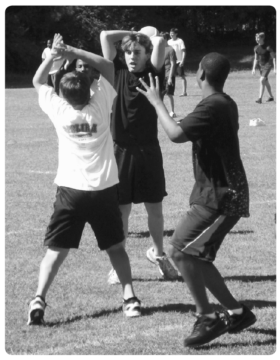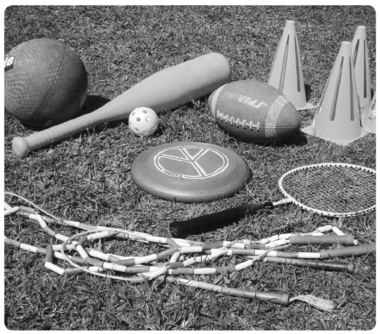An introduction to student-designed games
This is an excerpt from Student-Designed Games by Peter Hastie.
For many of us, some of our best childhood memories revolve around playing games after school with our friends. Most of the time, these games were created with whatever equipment we could muster (or make), and in all cases, they were free from adult interference. The games were formal in that they involved rules, teammates, and scores, but they were informal in that they were made by us, and for us, with the key goal of challenging our abilities in the name of fun. This spontaneity and creativity is so often missing in physical education, with the result that game play becomes the province of the most skillful to the exclusion of many others.
It is the purpose of this book to introduce you to the process of teaching games making as a way of engaging all students in your classes, essentially by making games for learning instead of playing games for learning.
By definition, games making in physical education is a process where students create, organize, implement, practice, and refine their own games within certain limits presented by the teacher. These games are considered a major tool for enhancing student interest, and some have suggested they often bring forth more interest than do teacher-designed games (Rovegno & Bandhauer, 1994).
Games making, is not, however, a simple case of the teacher giving students some equipment and saying, "Go make up a game." Taught well, games making provides a means through which students can do the following:
- Engage actively with and explore components of game play (skills and strategy) and, in turn, construct a deeper understanding of these components
- Think critically about their experiences playing games and sports at recess and after school
- Learn how to learn cooperatively and solve problems in groups
The key is that students follow a sequence of (1) design, (2) trial, and (3) refine to get to a point where the game is ready to be presented, explained, and demonstrated to the class before being played and evaluated by others.
A Brief Theory of Student-Designed Games
The fundamental premise underlying why students should be involved in game design is this: When anything is created, be it a piece of art, a delicious dessert, or a science project, the greatest learning benefit remains reserved for those engaged in the design process (the game designers), and not those at the receiving end. So it is with games. When we play traditional games, the game player is not part of the discussions involved in developing the ideas, designs, and strategies of those games.
Of further importance is that games making is a collaborative process. In designing games, student learning takes place within a culture in which there are rich interactions between members of the community (in our case, the class). These interactions are central to games making because groups not only work together to design games but also, by presenting and trialing them with other students, get feedback before the final product is presented. The games developed during units of student-designed games therefore become what are called shareable artifacts. These artifacts are public entities in that they are specifically designed to be shared with other members of the class rather than as products to be submitted to a teacher for examination.
As mentioned, the goal of student-designed games is to facilitate knowledge construction, invention, and reflection. To do this, we need what Papert (1993) calls "objects-to-think-with." These objects are all those pieces of equipment such as bats and balls that students can use to construct, examine, and revise connections between old and new knowledge. It is important, then, that you are able to provide students with a wide range of equipment during the design process. Although not all equipment will be used, having a larger inventory will allow for greater creativity.

What Makes a Good Game?
One only has to read any of the blogs and communiqués among the fans of computer games to get a ready understanding of what makes a good game. In general, there are two commonly agreed-upon principles:
- It's possible to increase in skill almost indefinitely (variety and complexity).
- Score is directly proportional to skill for the most difficult tasks.
Of further interest is the idea that a good game is not necessarily directly equivalent to how fun a multiplayer game is. As Charles Kendrick, author of Designer's Guide to Multiplayer Quake Gameplay, has commented:
I tend to lose interest in any game where it's not possible to keep improving one's ability, or where improvements in ability don't show through in the game very much. If this isn't at least a little bit true of you, then ignore this document, and go back to work on your "kill everyone on the level by pressing a button." But if you're interested in creating a game with what I've defined as "good gameplay," or at least in creating a game that finds a balance between gameplay and more chaotic carnage, read on.
Essentially, Kendrick is speaking around a sense of a game being engaging. Engagement refers to the intensity and emotional quality of a person's active involvement during a task. If someone is highly engaged, we see evidence of enthusiastic participation, with high degrees of effort and positive emotion.
To be really engaging, an activity should
- be structured so that players can decrease or increase the level of challenge in order to match their skills,
- be easy for players to isolate the activity from other stimuli that might interfere,
- have clear performance criteria to let people know how well or poorly they are doing,provide concrete feedback to tell them how well they are meeting the criteria,
- and have a broad range of challenges and possibly several qualitatively different ranges of challenges.
Student-designed games fit easily into this definition. Students have the freedom to design games that match their skill levels and that have clear scoring systems that provide them with feedback. As a result, it is not unusual to see games-making lessons characterized by serious and thoughtful engagement rather than more frivolous expressions of fun. As Rovegno and Bandhauer (1994) note from their experiences with student-designed games, "The true joy and deep fun individuals experience when they learn and participate in physical activities is not expressed through sport spectator behavior. There is great joy in playing hard, doing your best, learning movement, refining technique, and meeting the challenges of the game" (page 62).
Students do, however, need guidance as to what constitutes a good game. These characteristics need to be explicitly presented to students. In essence, their games must
- contribute to skill development;
- be safe;
- include, not eliminate, students from participation (elimination makes almost no pedagogical sense when one considers that the most likely students to be eliminated are those who have the least skill and in fact need the most practice);
- have high participation rates;and
- be structured so that all children are successful and are being challenged.
A good game, then, is one that is fun, fair, and safe for all participants. By fun, we mean that the game involves participants at an appropriate level of challenge from the perspectives of both skills and strategies. By fair, we mean that the game has a good balance so that success and scoring are not too easy or too hard. That is, there is a good balance between the offense and the defense so that neither one dominates play. By safe, we mean the game has rules that keep its participants physically safe, and there are no opportunities for students to be embarrassed or humiliated.

SHOP

Get the latest insights with regular newsletters, plus periodic product information and special insider offers.
JOIN NOW


